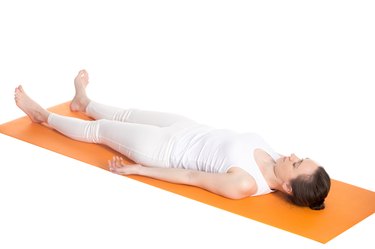
A pneumothorax can be a serious lung condition that causes difficulty with breathing, sharp chest pain and chest tightness. A pneumothorax occurs when air escapes from the lungs and fills the pleural space, which is the area between the lungs and the chest wall. The air cannot escape and presses on the lung tissue, making it hard to breathe. It is typically caused by something that punctures the lung tissue, such as a broken rib or penetrating trauma, although some conditions occur spontaneously. Sometimes a chest tube is necessary to drain excess air or accumulated fluid. Your doctor might prescribe some breathing exercises to perform as you recover from a pneumothorax.
Importance
Video of the Day
Breathing exercises after a pneumothorax are beneficial as part of your treatment methods. Not performing the exercises could lead to a stiffening of the muscles of the rib cage. This can make breathing more difficult or painful as the stiffened muscles try to expand. Additionally, taking small, shallow breaths can lead to decreased oxygen intake. Oxygen is necessary to help the body heal and to maintain your activity levels without becoming lethargic.
Video of the Day
Benefits
Breathing exercises after a pneumothorax help to keep your lung tissue elastic, making your efforts at breathing a little easier. Additionally, deep breathing and coughing reduces the incidence of further atelectasis, which occurs when the tiny air sacs of the lungs, known as alveoli, contract and collapse on themselves. The action of taking deep breaths pushes air into the alveoli, which can help to keep them open. These air sacs are responsible for exchanging oxygen and carbon dioxide with the bloodstream, and atelectasis can reduce the amount of oxygen that your blood can carry to your tissues.
Exercises
You can practice deep breathing exercises to help you to heal from a pneumothorax. Lying on your back, place the palms of your hands on your abdomen at the lowest level of your ribs. Breathe in slowly and deeply, using your abdomen to draw air into your lungs. According to a webpage on the University of Missouri website, this type of exercise will help to deliver air to the lower parts of the lungs, which can reduce the incidence of atelectasis. You may also consider making a humming sound when you exhale. Draw in a long, deep breath and hum as you breathe out, trying to hold the sound for as long as possible. Practice this type of breathing exercise for two to three minutes.
Considerations
Follow the directions given by your doctor or nurse for practicing breathing exercises after a pneumothorax. You also need rest as your lung heals, so avoid overdoing the exercises to speed the process. Concentrate on your breathing and avoid panting or taking repetitive, shallow breaths. This type of hyperventilation can cause dizziness or could lead to injury. If you feel sharp pain or sudden shortness of breath, stop the exercises and contact your doctor.